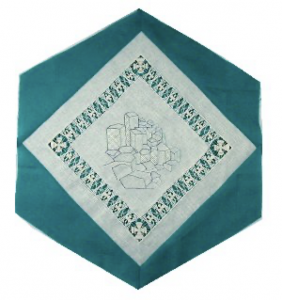Northern Ireland

The Block
This block depicts County Antrim’s famous geologic formation, ‘The Giant’s Causeway,’ huge basalt rock formations that resulted from volcanic eruptions. Over 40,000 tightly packed and mostly hexagonal columns are said to have been created as a roadway across the Irish Sea by giants. On a background of Belfast linen, blockmaker, Cynthia Jackson, used pulled thread work, a technique in which stitches are used to pull selected threads very tightly to form patterns of holes in the fabric. This complex technique was used to create a design of different textures and depths to portray The Causeway. A border of drawn thread work, a technique in which some fabric threads are removed from the material, while others are tied to form patterns frames the piece. The shamrock, a traditional emblem of Northern Ireland, is incorporated into the border, while its corners are anchored by St. Patrick’s crosses, accented in fine silver and gold thread.
Cultural Profile
Northern Ireland, part of the United Kingdom, is a six-county territory with beautiful landscapes, green mountains, lakes and rugged coastline. Its capital, Belfast, took its name from Beal Feirsde, Irish for ‘the mouth of the sandbank.’ Almost all residents speak English, with only a small percentage using Irish Gaelic.
At one time, the linen industry was the mainstay of many Irish. Farmers across most of Northern Ireland grew and processed flax which was spun into linen thread and hand-woven into cloth. Belfast and its surrounding areas became the world’s leading producer of the renowned Irish linen fabrics. Following the near collapse of the industry in the 1950s, production decreased and nowadays only small specialist companies remain, producing luxury linen items.
A Celtic country, Northern Ireland has a distinctive cultural identity which draws on Irish, British and Scottish influences. While some symbols and celebrations are closely associated with particular groups and organizations others, like St. Patrick’s Day and the flax flower, are adopted by all. Music, folk singing and dancing all play important roles in Northern Ireland, as well as storytelling. The urban landscape of Northern Ireland is also known for its murals, often politically-charged, but always powerful, painted on the end wall of terraced houses.
Ireland is well-known for its lace-making, with special styles such as Irish crochet lace, Carrickmacross lace, limerick lace, and bobbin lace. Lace-making was once a cottage industry for women, especially during the great Potato Famine of the 1840s, as it was a way to earn much-needed income for families. Northern Ireland is also known for its embroidery, featured on linens, handkerchiefs and dresses. Ornately decorated ceramics are made in County Fermanagh.
During the Potato Famine of 1845, millions of Irish emigrated to countries around the world to avoid starvation. Records indicate that people from Northern Ireland have been coming to Canada since 1974; before that they were listed under British/Irish. They quickly established themselves as farmers and, because they spoke English, participated more directly in Canadian society than many non-English speaking immigrants. Today approximately 13 percent of the Canadian population is of Irish descent, impacting almost all parts of the Canadian social and economic fabric.
Sponsor: Julia (Crawford) Coulter, Rachel (Coulter) Ullman
